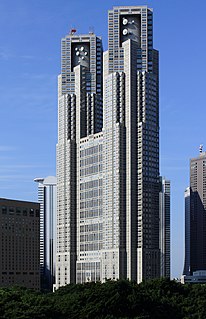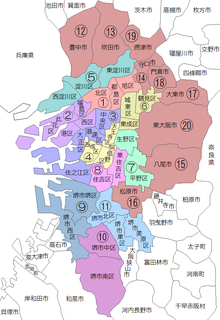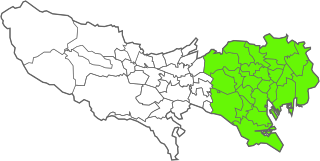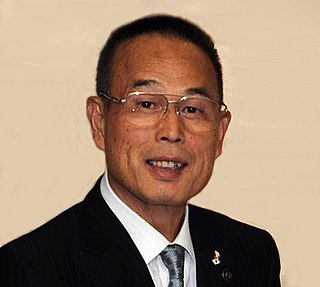This article presents detail of the results in the Japan general election, 2005, breaking down results by block district. The 11 block districts elected 180 members by proportional representation, and 300 members were elected from single-member districts distributed among the 47 prefectures.

The Tokyo Metropolitan Government is the government of the Tokyo Metropolis, one of the 47 prefectures of Japan. The government consists of a popularly elected governor and assembly. The headquarters building is located in the ward of Shinjuku. The metropolitan government administers the 23 Special Wards of Tokyo, as well as the other cities and towns that constitute the prefecture. With a population closing in on 14 million living within its boundaries, and many more commuting from neighbouring prefectures, the metropolitan government wields significant political power within Japan.
Prefectural elections were held in Tokyo for the city's Metropolitan Assembly on June 24, 2001. The Liberal Democratic Party (LDP) and New Komeito Party secured their positions as ruling parties. Japanese Communist Party (JCP) lost almost half its seats while Democratic Party of Japan (DPJ) saw an increase by ten seats.
Prefectural elections for the Tokyo Metropolitan Assembly were held on 12 July 2009. In the runup to the Japanese general election due by October they were seen as an important test for Taro Aso's ruling coalition of the Liberal Democratic Party (LDP) and the New Komeito. New Komeito considers Tokyo as an important stronghold and had repeatedly asked Prime Minister Aso to avoid holding the two elections within a month of each other.

The 22nd Elections to the House of Councillors for the upper house of the legislature of Japan were held on July 11, 2010. In the last election in 2007, the Liberal Democratic Party (LDP) lost its majority to the Democratic Party (DPJ), which managed to gain the largest margin since its formation in 1996. The House of Councillors is elected by halves to six-year terms. The seats up for election in 2010 were last contested in the 2004 election.

The Osaka Restoration Association, also referred to as One Osaka, is a regional political party in Osaka Prefecture, Japan. Founded in 2010 by then-Governor Tōru Hashimoto, its main platform is pursuing the Osaka Metropolis plan of merging the prefecture and some of its cities into "One Osaka" and reducing overlapping bureaucratic organizations of Osaka Prefecture and the city of Osaka.

The 11th Okinawa gubernatorial election was held on November 28, 2010. The official campaign start began November 11. The 2010 election garnered national attention mostly for the dispute between the central government and local communities in Okinawa over the planned relocation of Marine Corps Air Station Futenma from Ginowan to Henoko in Nago that had also contributed to the resignation of prime minister Yukio Hatoyama in June 2010.
This article lists events in 2011 in Japan.
Aichi 6th district is a constituency of the House of Representatives in the Diet of Japan. It is located in Northwestern Aichi and consists of the cities of Kasugai, Inuyama and Komaki, part of the Chūkyō Metropolitan Area around Nagoya. As of 2012, 420,807 eligible voters were registered in the district.
The Tōkyō proportional representation block is one of eleven proportional representation (PR) "blocks", multi-member constituencies for the House of Representatives in the Diet of Japan. It consists solely of the prefecture of Tokyo making it one of two blocks covering only one prefecture, the other being Hokkaido. Following the introduction of proportional voting Tokyo elected 19 representatives by PR in the 1996 general election, and 17 since the election of 2000 when the total number of PR seats was reduced from 200 to 180.
The 16th unified local elections in Japan took place in April 2007. In the first phase on April 8, 2007 13 governors, 44 prefectural assemblies as well as four mayors and 15 assemblies in cities designated by government ordinance were elected. In the second phase on April 22, 2007 mayors and/or assemblies in hundreds of cities, special wards, towns and villages were up for election. Additionally, by-elections for the national Diet were held in Fukushima and Okinawa on April 22.
Events in the year 2012 in Japan.

The Osaka Metropolis plan or Osaka Metropolis is a plan to transform Osaka Prefecture from a fu, an urban prefecture, into a to, a metropolis. Under the initially envisioned plan, Osaka city, Sakai city, and other surrounding cities in Osaka prefecture, were to be dissolved and – similarly to Tokyo urban wards within Tokyo – subdivided into special wards that have a status as municipalities but leave some municipal tasks and revenues to the prefectural administration. As political resistance grew, notably the opposition to the plan in Sakai city expressed in the 2013 mayoral election, the concrete plan was reduced to, at least as a first step, abolish only Osaka city. As in Tokyo, the metropolis would have continued to include all other municipalities of the prefecture and serve as prefectural government for them.
Politics of Osaka City, as in all municipalities of Japan, takes place in the framework of local autonomy that is guaranteed by chapter 8 of the Constitution and laid out in the Local Autonomy Law. As one of Japan's 20 major cities designated by government ordinance, Osaka City has some administrative responsibilities that are handled by the prefectures in ordinary municipalities and is subdivided into wards.

The Aichi Prefectural Assembly is the legislative assembly of Aichi Prefecture.

The 47th general election of members of the House of Representatives of Japan was held on 14 December 2014. Voting took place in all Representatives constituencies of Japan including proportional blocks, in order to appoint Members of Diet to seats in the House of Representatives, the lower house of the National Diet of Japan. As the cabinet resigns in the first post-election Diet session after a general House of Representatives election, the lower house election also led to a new designation election of the prime minister in the Diet, and the appointment of a new cabinet. The turnout in this election is the lowest in Japanese history.
The first stage of the 18th unified local elections in Japan took place on April 12, 2015. The Liberal Democratic Party under leadership of Shinzo Abe was the overall victor, winning many races including all ten gubernatorial races and 1,153 of the 2,284 assembly seats at stake. Further elections for municipal mayors and assemblies took place on April 26.

The 24th regular election of members of the House of Councillors was held on Sunday 10 July 2016 to elect 121 of the 242 members of the House of Councillors, the upper house of the 717-member bicameral National Diet of Japan, for a term of six years. As a result of the election, the LDP/Komeito coalition gained ten seats for a total of 146, the largest coalition achieved since the size of the house was set at 242 seats.
The 2015 Hyōgo prefectural election was an election for the Hyogo Prefectural Assembly held on 12 April 2015 as part of the 2015 unified local elections in Japan. The election saw the number of assembly members reduced from 89 to 87 and the number of electoral districts reduced from 41 to 40. Voting was held in 23 districts and representatives for the remaining 17 districts were elected unopposed. The election was held in the wake of the political expenses scandal that was exposed in July 2014 involving multiple assembly members and was notable for former assemblyman Ryutaro Nonomura's outburst of uncontrolled sobbing at a news conference.

Prefectural elections for the Tokyo Metropolitan Assembly were held on 2 July 2017. The 127 members were elected in forty-two electoral districts, seven returning single members elected by first-past-the-post, and thirty-five returning multiple members under single non-transferable vote. Four districts had their magnitude adjusted in this election to match population changes.



















